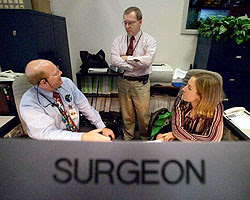
"If a little kid ever asks you why the sky is blue,
you look him or her right in the eye, and say,
'It's because of quantum effects involving Rayleigh scattering
combined with a lack of violet photon receptors in our retinae.'"
~ Astronomer Phil Plait, who might not get invited
to speak at too many elementary schools
Are you strong enough to be wrong? My heroes in this intellectual sport include many eminent scientists who experienced ruggedly exhausting searches for knowledge, rigorous education, intense periods of frustration, depressing self doubt, insatiable curiosity, crises of faith, and if one is very lucky, enlightenment or validation.
Those last two count for tiny portion of thinkers' lives. Even the powerhouses! Einstein expressed extreme doubt with the accuracy of his work, and Hawking has famously made bets where he acknowledges the limits of his predictions, and promises to pay up if he is proven incorrect.
Superman Pose!
I for one think these traits are part and parcel of great scientific minds. No one is right all the time, but if you are highly, highly intelligent, being wrong can not only be painful -- but downright career-killing, depending on circumstances.
Still, I'm am steadfast in my judgment of this quality as separating the narcissistic egos with high I.Q.s from the kind of scientists who make the world a better place.
I got to have lunch with one of my intellectual heroes at
SpaceFest V this past spring,
astronomer Philip Plait. We've crossed paths on Twitter and blog comment forums in the past -- and if you aren't following his blog,
Bad Astronomy, you're missing one the very best examples of someone who mythbusts for a living, while championing the joys of the Scientific Method.
"Bad Astronomy" refers to misconceptions about science, and Plait specializes in setting the record straight, battling pseudoscience, and describing in layman-friendly terms all the delightful things in our universe that might happily kill you. Hence, his two tomes,
Bad Astronomy, and
Death From The Skies.
In both books, and his blog, he often must battle those engaged actively
in anti-science, an astonishingly large movement for our alleged "age
of information". If you're scientifically-minded, and have ever taken
on a creationist, climate-change denier, moon landing hoaxer,
anti-vaxxer, or other conspiracy theorists who use fringe arguments to
defend easily debunked beliefs, you've already seen the difference
between wishful thinking and empirical examination.
Impressing Phil With My First Edition,
which he simply called... "OLD". Thanks.
Often the desire to seem "unique" in terms of intelligence is the driving force behind conspiratorial issues or "group-think" -- but, true intelligence is based on ability to doubt, to question, to engage in skepticism, or to embrace possibly the best book-ending line in all of literature, by Richard S. Bach:
"Everything in this book... could be wrong." (Illusions, 1977)
Everything you think, at any time, could be wrong. It's a difficult concept to live by, but necessary. Conspiracy theorists may essentially cling to irrational beliefs, are terrified of challenge, and upon hearing actual facts, often dig in their heels to double-down on their chosen fiction.
Science, in contrast, says: PROVE IT. Sell me. Give me a new model, and we will give up the old one. Publish it. Let everyone weigh in. Let someone else observe and repeat. Hey, look...new and improved science!
Science, after all, is not merely a method. The Latin "scientia" does not mean deviation from a deity, as some might claim, to advance on their agenda; the root prefix indicates "a body of knowledge" or a collection of facts observed.
Is it always pretty? Oh dear me no, scientists fight like rabid bats. There's a great deal of biting and flapping... because, when you get right down to it, REALITY is on the line.
Fixed.
Knowing that I feel this way -- imagine me watching Phil Plait, upon autographing his "old" book, grumbling that he wished he could market a re-printing to correct where his research was out of date. He flipped until he found the offending section, crossed it out, and assured me more accurate information was now available. He wrote one word: WRONG.
I was stunned. Stunned, I tell you. A few years ago, I handed astronaut Buzz Aldrin a book to sign, where he crossed out "Edwin"(no longer his legal name), and wrote "Buzz" in it's place! Until now, that was the oddest signing experience I'd ever had. This was something wholly different, though no less about the identity of the signer.
This correction, to me, is even more valuable than the title page autograph! This is absolutely what science is all about. When Phil and I parted ways, I kept flipping through the book and looking at the page, enamored of the idea that he actually took the trouble to FIND and so openly acknowledge it -- because he didn't want me to be misinformed.
This is why I read his books. This is why I read his blog. I don't blindly believe everything he says. I don't always agree with him. And I don't have to. Embracing science means always questioning, sometimes challenging, and always wanting to be as objective as possible.
That's a real scientist. Why don't they have HIM on "The View" ??































